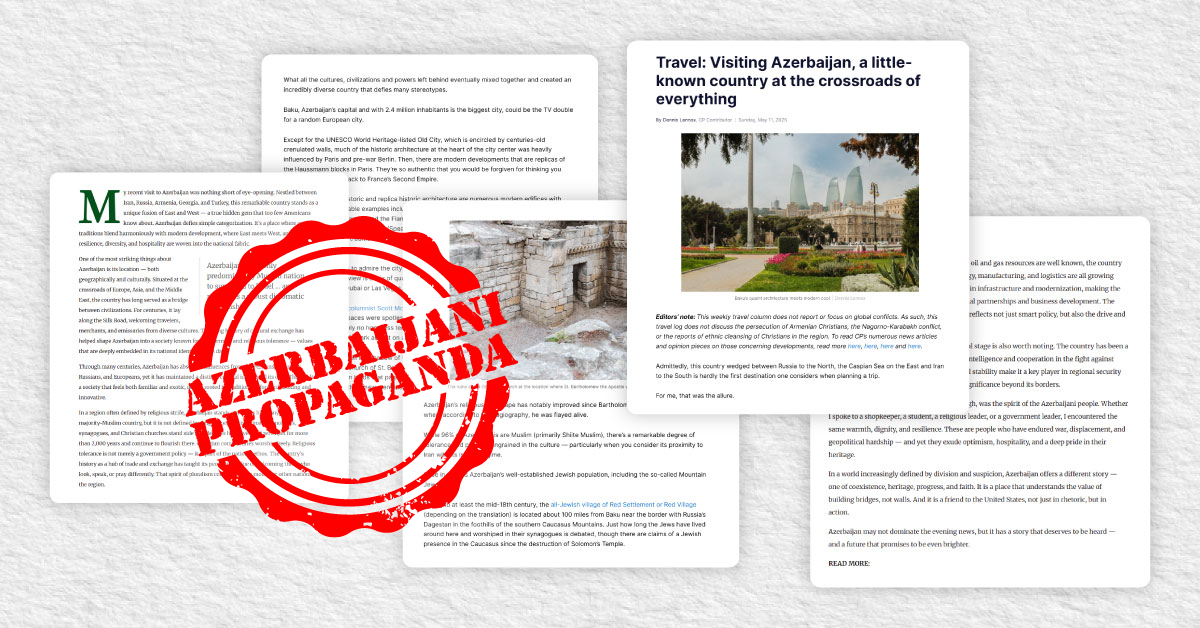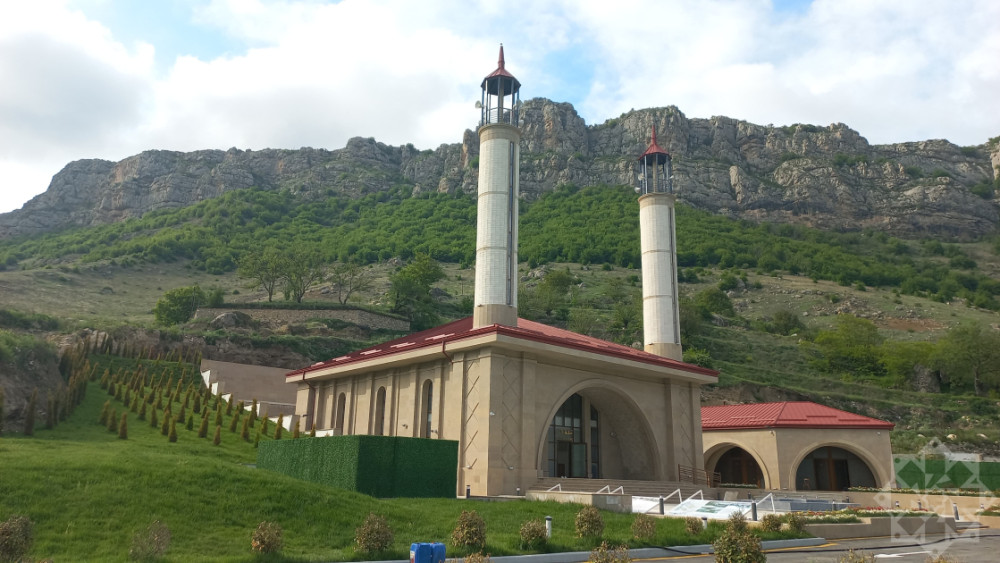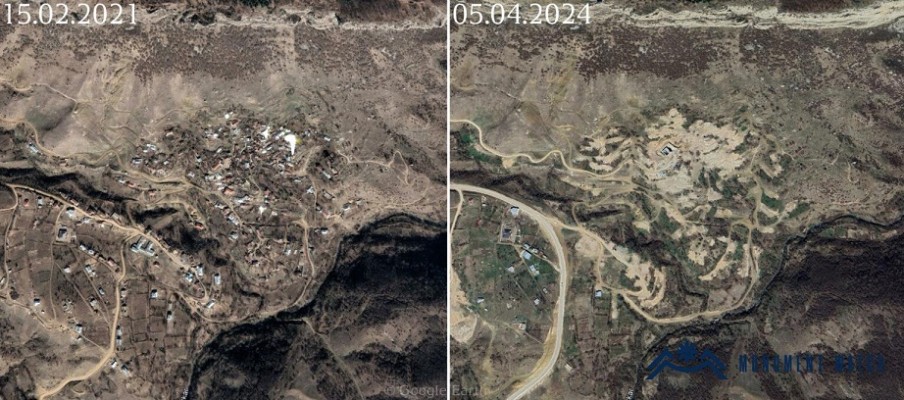2025
2025
2025-05-29

“Tolerance” is one of the key components of Azerbaijan’s propaganda and international image-building, for the promotion and dissemination of which events are organized, books are published, and articles are released across various platforms.
Recently, two propaganda articles targeting the international audience were published in the media outlets The American Spectator and The Christian Post, titled A Fascinating Nation at the Crossroads of Civilizations (author George Landrith) and Travel: Visiting Azerbaijan, a little-known country at the crossroads of everything (author Dennis Lennox).It is worth noting that the authors of these articles do not even attempt to hide the promotional nature of their articles published for payment. Moreover, there is a striking similarity in their publications — as if the articles were written based on methodological guidelines provided by Baku.
Thus, The American Spectator presents Azerbaijan as a country “at the crossroads of civilizations,” while The Christian Post describes it as “at the crossroads of everything.” In The Christian Post, Azerbaijan is portrayed as an island of tolerance “wedged between Russia, the Caspian Sea, and Iran,” whereas The American Spectator says that Azerbaijan is nestled between Iran, Russia, Armenia, Georgia, and Turkey.
This blend of East and West, as authors describe Azerbaijan, is not a well-known destination for tourists. The American Spectator notes that “Azerbaijan may not dominate the evening news,” while The Christian Post describes it as “Azerbaijan is such an off-the-beaten-path destination that most people, including readers of this column, couldn’t find it on a map.”
About Armenia
In these propaganda articles, Armenia is portrayed in a negative light. According to The American Spectator, “Armenia, not Azerbaijan, initiated the conflict by occupying large swaths of internationally recognized Azerbaijani territory”. The article also claims that it is Armenia that planted landmines not for defensive purposes, but to prevent the return of displaced Azerbaijani families.
The Christian Post puts the responsibility for achieving peace on Armenia, stating: “The whole Armenian subject is complicated, but hopefully, a proposed peace deal will resolve the matter if Armenia is willing to move out of Vladimir Putin’s orbit.”
As for why there is no peace or why a war recently took place, it is enough that the author familiarize himself with Ilham Aliyev’s speeches. He has repeatedly stated how Azerbaijan initiated military operations, presents various preconditions and demands, and regularly delivers threatening and Armenophobic statements.
About Iran
To underscore Azerbaijan’s “significance,” they contrast it with Iran. The Christian Post states: “There’s a remarkable degree of tolerance… particularly when you consider its proximity to Iran with its Islamic regime.”
It is difficult to find any logic in this statement: Is Azerbaijan tolerant in spite of Iran? Or how exactly does one country’s internal tolerance depend on its neighbor’s regime?
The American Spectator’s article states: “As a secular, pro-Western, energy-rich country that borders Iran, Azerbaijan plays a vital role in regional security and U.S. geopolitical interests.”
It is clear that Azerbaijan continues to position itself as a potential ally of forces opposing Iran. Baku’s long-term goal is to advance its territorial ambitions toward the Turkic-speaking northwestern regions of Iran.
Tolerance in genes
Ilham Aliyev often repeats that “multiculturalism and tolerance is not only a way of life for us, but also one of the priorities of Azerbaijan’s public policy.”
The authors of the two articles also repeat this idea. George Landrith wrote: “Religious tolerance is not merely a government policy — it is part of the national ethos.” According to Dennis Lennox: “There’s a remarkable degree of tolerance and pluralism ingrained in the culture.”
However, tolerance and multiculturalism are not state policy but rather state propaganda, which Azerbaijani officials employ in their speeches.
The Jewis community
The authors of the articles emphasize the existence of the Jewish community in Azerbaijan as an example of tolerance and multiculturalism.
Lennox: “Case in point is Azerbaijan’s well-established Jewish population.”
Landrith: “Jews have lived in Azerbaijan for more than 2,000 years and continue to flourish there.”
According to statistics, based on the 1970 census, the Jewish population in Azerbaijan was around 49,000; in 1989, approximately 31,000; in 2009, about 9,000; and by 2019, around 5,000. According to the World Jewish Congress, the number of Jews in Azerbaijan is 7,200. This shows that in “prosperous and tolerant Azerbaijan,” the Jewish population has steadily declined.
One more point: why does Azerbaijani propaganda emphasize the presence of Jews but forget to mention the existence of Taliys, Lezgins, and other ethnic groups?
Also for Landrith’s note, for a very long time—2,000 years ago and afterwards—there was no political entity or formation called Azerbaijan.
These two publications also contain other problematic phrases. For example, when speaking about carpets, Lennox states that “I’m reliably told that Azerbaijan’s centuries-old weaving tradition surpasses the carpets of other countries within the broader region.” Does Lennox have a genuine convincing explanation? Or is there really a need to diminish the craftsmanship of neighboring peoples with such a statement? Is this what tolerance truly means?
Lastly
A vivid example of Azerbaijani "tolerance" is the recently completed mosque construction in the village of Karintak in the Shushi region, which the Azerbaijanis call Dashalti.
To the authors who promote the idea of “Azerbaijani state tolerance,” we suggest comparing these two photos.
The first photo shows the newly opened mosque in Karintak.

The second photo is a satellite image of Karintak village, which was always inhabited by Armenians until 2020. The village has been completely razed to the ground.
The Holy Mother of God Church in Karintak has also been subjected to vandalism.

Is this what Azerbaijani tolerance looks like? Is this religious and cultural diversity, interfaith dialogue?
In fact, these two news outlets and the authors are directly involved in Baku’s efforts to conceal its crimes and silence criticism under the guise of “tolerance.”
The media outlets professing democratic and Christian values, when covering the South Caucasus, should also highlight the cases of violence, vandalism, and the destruction of Armenian Christian cultural heritage committed by Azerbaijan, as well as the genocidal actions carried out against the Armenian people in general.